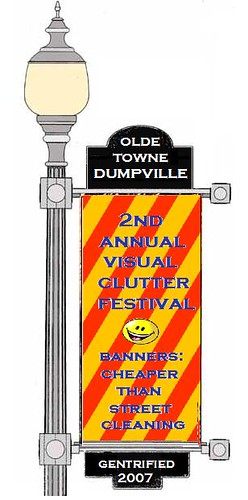
An off-topic note on Northeast Washington’s esteemed Frozen Tropics neighborhood blog set me off on a rant about those ubiquitous lamppost banners. Hate ’em.
Banners are an urban plague. In attractive neighborhoods, they distract from good design, like a South of the Border bumper sticker on a classic car. In developing neighborhoods they are lipstick on a pig, obvious and pathetic wishful thinking.
A couple of thunderstorms and your lampposts are festooned with rags. Put the money into a facade improvement project instead.
Image by Mike Licht. Download a copy here. Creative Commons license; credit Mike Licht, NotionsCapital.com
July 3, 2008 at 10:49 am
FYI: we have new banners in bloomingdale.
July 3, 2008 at 12:12 pm
IMGoph: In isolation, the Bloomingdale graphic is more visually-pleasing than most, but the photos of the series of them in situ makes my point. They do not decorate and celebrate — they distract.
The individual banner is not the work — the series of banners is the work, and a series of banners is boring at best, and does not bear repeated viewings. It looks contrived because it is contrived.
If you really feel the need to hang similar things from lampposts (Lord knows why), put up baskets of flowers — at least the chore of tending them seems to make neighbors (or BID employees) more conscientious about keeping the streets clean.
July 3, 2008 at 3:56 pm
In Residential neighborhoods, banners should be removed because they take away the beauty from the houses. But they should stay in the business sections of the streets like malls. The banners will stay in a high traffic area but will not take away the beauty because most malls are tacky.
July 3, 2008 at 4:43 pm
Shortshire:
I think business owners would much rather have passers-by look at their store signs than banners, don’t you?
Banners are visual clutter wherever they appear, and should be eradicated.
July 4, 2008 at 9:17 am
I don’t think of lampost banners as visual clutter per se. I think they *can* be just a subtle streetscape embelishment that shows community pride, which is a purpose that shouldn’t be wholly discounted. I think the Truxton Circle ones photographed at inshaw are pretty good banners. The 14&U ones are admittedly the worst.
That said, I think most banners are so generic in their message that any neighborhood or town could be substituted for the one being promoted E.g., “______is a place to live, shop, dine, AND play!!!!!” And no banner is going to convince a person that the message is true.
I agree that hanging baskets are more desirable than banners, and I think when well done they’re far from “visual clutter.” Downtown Greensboro, NC, has them on every lampost, and I think they add a lot to the streetscape and pedestrian experience. While beautiful old architecture, stores, residences, and restaurants abound, I think the hanging baskets add a splash of color and life, give a cohesive look, demonstrate investment, and generally make the pedestrian experience more enjoyable.
July 4, 2008 at 11:43 am
We’ve been discussing this on Richard Layman’s slightly more rarified urban planning blog, Urban Places and Spaces.
My slightly-more-pretentious comments from that:
A series of banners (it is an error to look at one isolation) is an attempt to impose an artificial unity of identity on a place. It does so at the expense of distracting the viewer from the actual, organic semiotics of place, the signs and symbols that really distinguish one place from another.
The imposition of an identical garish nonsense message every 30 feet does not just cause the viewer to tune out the banner, but to tune out an area’s other symbols. A banner series actually masks the true identity of the very place it claims to celebrate.
What information consumes is rather obvious: it consumes the attention of its recipients. Hence a wealth of information creates a poverty of attention, and a need to allocate that attention efficiently among the overabundance of information sources that might consume it. — Herbert Simon